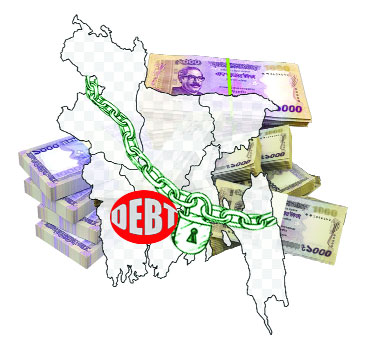Govt’s debt stood at Tk 14.48 trillion
Zarif Mahmud: The government’s total debt liability (domestic and foreign) stood at around Tk 14.48trillion (Tk14.48 lakh crore) till March. Mainly due to low revenue collection at the desired rate, incomplete implementation of austerity directives to control expenditure and appreciation of the dollar, the debt figure is increasing rapidly. In particular, the appreciation of the dollar has fueled external borrowing costs. The liability has reached such a level that it is equal to almost twice the current budget. Again, the cost of paying interest against the loan is also increasing. Only in the last financial year (for one year) Tk 80,476 crores of interest has to be calculated. The loan information is coming out as the latest from the finance department.
According to sources, the finance department has prepared the total debt of the government till March this year. This is the latest account of Finance Department. As it can be seen, out of the total debt, at the internal level i.e., the liability of the government in the banking sector is Tk 4.94 lakh crores and the debt liability of savings bonds and other sectors is Tk 4 lakh 21 thousand 34 crores. And the amount of foreign debt is Tk 5 lakh 33 thousand 198 crores.
Reviewing the report of the finance department, it can be seen that the total debt of the government till December 2022 was Tk 13 lakh 59 thousand 898 crores. From there, the amount of debt increased till last
March to Tk 14 lakh 48 thousand 333 crores. That is, the liability has increased by Tk 88 thousand 435 crores in three months.
If asked, the former caretaker government’s finance advisor AB Mirza Azizul Islam told Daily Industry that the revenue collection performance is not satisfactory. Revenue collection is far below target. On the other hand, government spending is not decreasing. Although austerity programs are given in some cases to reduce expenses, the instructions are not fully followed in many cases. Borrowing more to meet expenses. He also said that due to this more borrowing, the debt in the private sector will decrease. As a result, investment and employment will be adversely affected.
If you want to know, private research institute Center for Policy Dialogue (CPD) special follow Dr. Debapriya Bhattacharya told Daily Industry that there is no doubt that the government’s debt burden is increasing. Foreign exchange earnings are not increasing enough to pay for it. This is a very dangerous situation. Besides, the internal revenue has not gone to the point where revenue collection is increasing. In this context, there is a need for a review of the government’s debt situation. A strategy has to be worked out especially by estimating the medium term of the loan. There is no chance to keep the debt situation as it is.
The International Monetary Fund (IMF) calculates the credit risk score. According to this agency, a country can borrow up to 55 percent of its gross domestic product (GDP). If it goes beyond this, the country will be at risk. According to that, Bangladesh has borrowed 32.55 percent of GDP so far. Out of this, the domestic debt ratio is 20.57 percent and the foreign debt ratio is 12.01 percent. As a result, the finance department’s analysis has said that Bangladesh is risk-free in taking loans.
The former chief economist of the World Bank’s Dhaka office Zahid Hossain told Daily Industry that according to the analysis of the World Bank and IMF, Bangladesh is not yet at risk of debt in the long term. But the loan has to be paid in dollars. Now dollar crisis, dollars can’t be given elsewhere. That’s when the debt becomes burdensome. While there is no long-term risk, there is a short-term problem due to the shortage of cash dollars. He further said that no interference is possible in the repayment of loans. Because, the term is over, now it has to be paid. If not, there will be danger in taking loans again in the future.
It is known that the short-term loans from abroad have been taken at low interest rates. There are also long-term loans. Now comes the time to pay interest on short-term loans and principal on long-term loans. The entire foreign debt has to be repaid in US dollars. In the last fiscal year (2022-23), foreign loans of $170 crores were taken. On the contrary, $1.8 billion went into interest payments.
According to stakeholders, the loan portfolio has increased significantly after the Covid-19 hit. Due to which revenue collection is not as per target. According to the National Board of Revenue (NBR), NBR has achieved 89 percent of the revenue collection target set in the outgoing fiscal year (2022-23). NBR’s toll collection target was Tk 3 lakh 70 thousand crore. At the end of the year, it was seen that Tk 3 lakh 31 thousand 502 crores were collected.
Apart from this, additional costs, slow financial growth is also one of the reasons. Now, to continue with other priority projects, the budget deficit will have to increase. But to increase this deficit, more loans will be required. If not, the government should be frugal. Although many talk of cost saving is heard, it is not effective in thick spots. All together will be under a kind of pressure with debt.
According to sources, on the one hand, a package was announced to recover the economy, including emergency management of the health sector, vaccination programs, and on the other hand, the government took special initiatives to get foreign aid. As a result, in 2019-20 fiscal year, $ 240 million, $655 million in 2020-21 fiscal year and $ 459 million in 2021-22 fiscal year were received from abroad.
Rare Israeli airstrike in Beirut kills Hezbollah commander and more than a dozen others
International Desk: Israel launched a rare airstrike that killed a senior Hezbollah milita…








